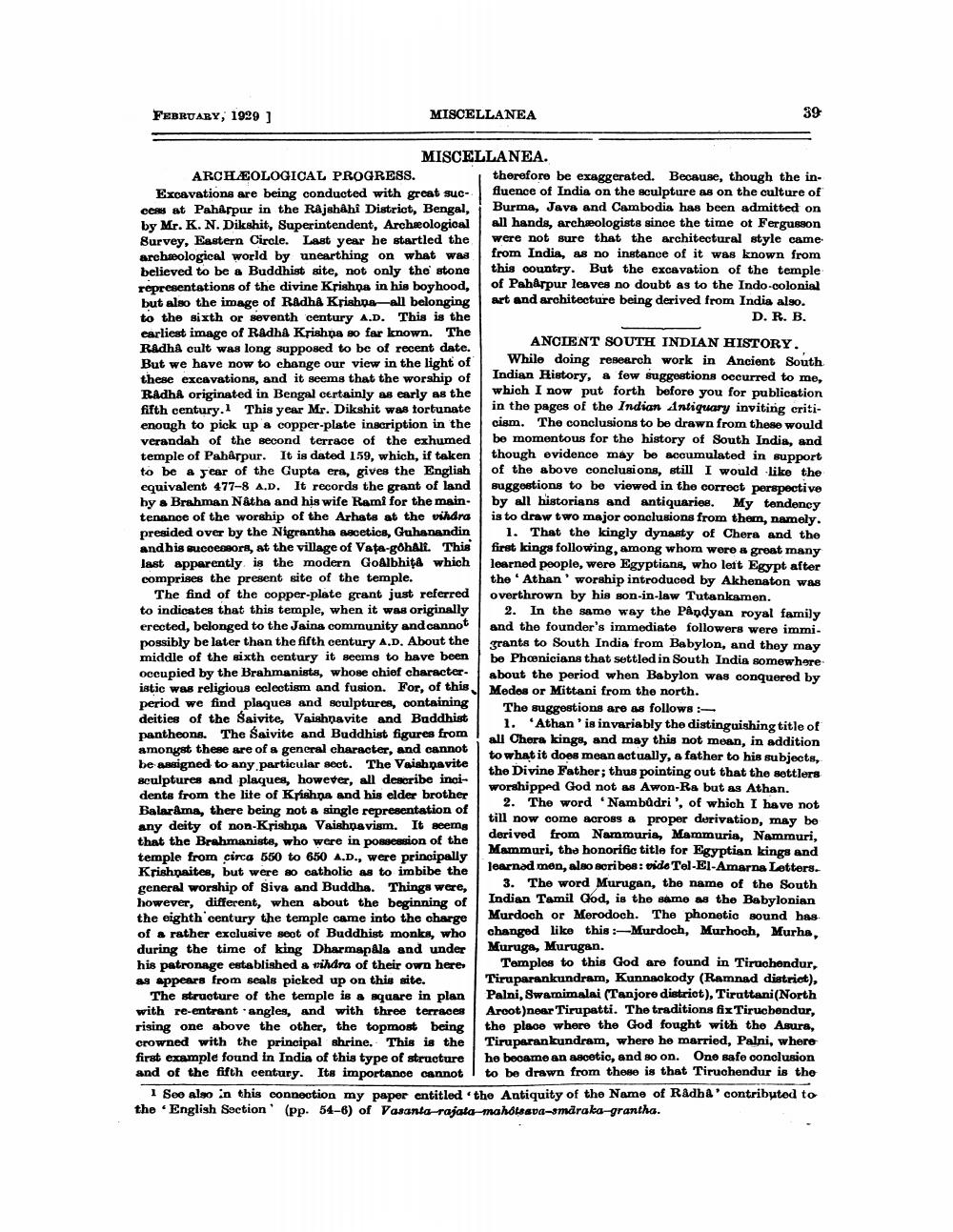________________
FEBRUARY, 1929 ]
MISCELLANEA
MISCELLANEA. ARCHÆOLOGICAL PROGRESS.
therefore be exaggerated. Because, though the inExcavations are being conducted with great suc- fluence of India on the sculpture as on the culture of cers at Paharpur in the Rajshahi District, Bengal, Burma, Java and Cambodia has been admitted on by Mr. K. N. Dikshit, Superintendent, Archeological all hands, archaeologists since the time of Fergusson Burvey, Eastern Circle. Last year he startled the were not sure that the architectural style o arebiological world by unearthing on what was
from India, as no instance of it was known from believed to be a Buddhist site, not only the stone this country. But the excavation of the temple representations of the divine Krishna in his boy hood, of Paharpur leaves no doubt as to the Indo-colonial but also the image of RadhA Krishna-all belonging art and architecture being derived from India also. to the sixth or seventh century A.D. This is the
D. R. B. earliest image of Radha Krishna so far known. The RadhA cult was long supposed to be of recent date.
ANCIENT SOUTH INDIAN HISTORY. But we have now to change our view in the light of
While doing research work in Ancient South these excavations, and it seems that the worship of
Indian History, a few suggestions occurred to me, RADHA originated in Bengal certainly as early as the
which I now put forth before you for publication fifth century. This year Mr. Dikshit was tortunate in the pages of the Indian Antiquary inviting critienough to pick up a copper-plate inscription in the cism. The conclusions to be drawn from these would verandah of the second terrace of the exhumed be momentous for the history of South India, and temple of Pabárpur. It is dated 159, which, if taken though evidence may be accumulated in support to be a year of the Gupta era, gives the English of the above conclusions, still I would like the equivalent 477-8 A.D. It records the grant of land suggestions to be viewed in the correct perspective by a Brahman Nátha and his wife Rami for the main by all historians and antiquaries. My tendency tenance of the worship of the Arhats at the vihdra is to draw two major conclusions from them, namely. presided over by the Nigrantha ascetics, Guhanandin 1. That the kingly dynasty of Chera and the and his mucocors, at the village of Vata-gôhAli. This first kings following, among whom wore a great many last apparently is the modern GoAlbhit which learned people, were Egyptiana, who lett Egypt after comprises the present site of the temple.
the Athan worship introduced by Akhenaton was The find of the copper-plate grant just referred overthrown by his son-in-law Tutankamen. to indicates that this temple, when it was originally 2. In the same way the PÅpdyan royal family erected, belonged to the Jaina community and cannot and the founder's immediate followers were immipossibly be later than the fifth century A.D. About the grants to South India from Babylon, and they may middle of the sixth century it seems to have been be Phoenicians that settled in South India somewhere occupied by the Brahmanists, whose chief character about the period when Babylon was conquered by intie was religious eclectism and fusion. For, of this Medos or Mittani from the north. period we find plaques and sculptures, containing
The suggestions are as follows: deities of the Saivite, Vaishnavite and Buddhist
1. Athan' is invariably the distinguishing title of pantheons. The Saivite and Buddhist figures from
all Ohera kings, and may this not mean, in addition amongst these are of a general character, and cannot
to what it does mean actually, a father to his subjects, be assigned to any particular sect. The Vaishnavite
the Divine Father; thus pointing out that the settlers sculptures and plaques, howeter, all describe inci
worshipped God not as Awon-Ra but as Athan. dents from the lite of Krishna and his elder brother
2. The word 'Nambůdri', of which I have not Balarama, there being not a single representation of
till now come across a proper derivation, may be any deity of non-Krishna Vaishpa vism. It seems
derived from Nammuria, Mammuria, Nammuri, that the Brahmaniste, who were in possession of the temple from circa 650 to 650 A.D., were principally
Mammuri, the honorific title for Egyptian kings and Krishnaites, but were so catholie as to imbibe the
Joarnad men, also seribos: oido Tel-El-Amarna Lotters. general worship of Siva and Buddha. Things were,
3. The word Murugan, the name of the South however, different, when about the beginning of
Indian Tamil God, is the same as the Babylonian the eighth century the temple came into the charge
Murdoch or Morodoch. The phonetic sound has of a rather exclusive seat of Buddhist monks, who
changed like this Murdoch, Murhoch, Murha, during the time of king Dharmapala and under Muruga, Murugan. his patronage established a vihdra of their own here
Templos to this God are found in Tiruchendur, as appears from seals picked up on this site. Tiruparankundram, Kunnackody (Ramnad district), The structure of the temple is & square in plan
Palni, Swamimalai (Tanjore district), Tirattani(North with re-entrant angles, and with three terraces Aroot)near Tirupatti. The traditions fix Tiruchendur, rising one above the other, the topmost being the place where the God fought with the Asura, crowned with the principal shrine. This is the Tiruparankundram, where he married, Palni, where first example found in India of this type of structure he became an ascetic, and so on. One safe conclusion and of the fifth century. Its importance cannot to be drawn from these is that Tiruchendur is the
See also in this connection my paper entitled the Antiquity of the Name of Radha contributod to the English Soction (pp. 64-6) of Vasanta-rajata-mahotsava-smdraka-grantha.




